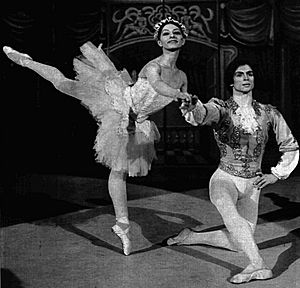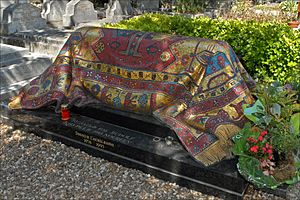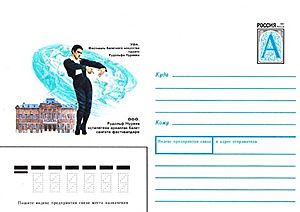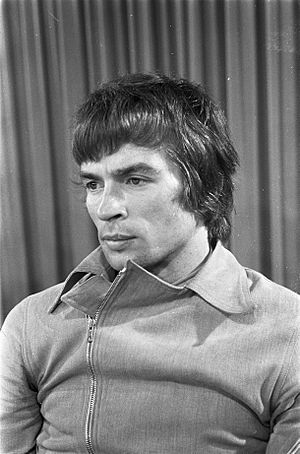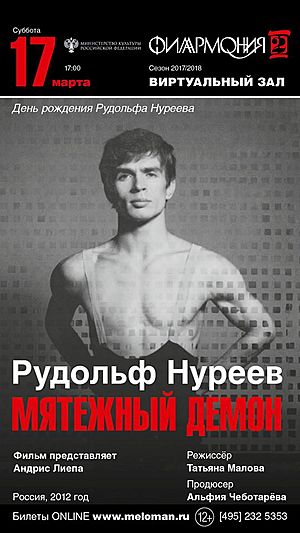Rudolf Nureyev facts for kids
Quick facts for kids
Rudolf Nureyev
|
|
|---|---|
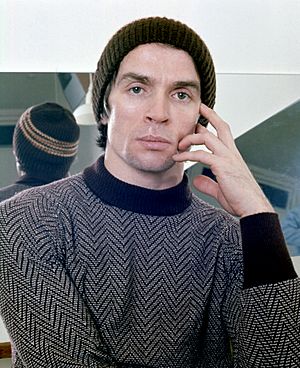
Nureyev in 1973
|
|
| Born |
Rudolf Khametovich Nureyev
17 March 1938 Near Irkutsk, Russian SFSR, Soviet Union
|
| Died | 6 January 1993 (aged 54) Levallois-Perret, France
|
| Resting place | Sainte-Geneviève-des-Bois Cemetery, Paris, France |
| Citizenship |
|
| Alma mater | Kirov Ballet School |
| Occupation |
|
| Years active | 1958–1992 |
| Height | 173 cm (5 ft 8 in) |
| Partner(s) |
|
Rudolf Khametovich Nureyev (1938–1993) was a famous ballet dancer and choreographer. He was born in the Soviet Union. Many people believe Nureyev was the greatest male ballet dancer of his time.
He started his career with the Kirov Ballet in Leningrad. In 1961, he made a big decision to leave the Soviet Union and move to the West. This was a very unusual event during the Cold War. It made him famous around the world. After that, he danced with The Royal Ballet in London. From 1983 to 1989, he was the director of the Paris Opera Ballet. Nureyev also created his own versions of many classic ballets. These included Swan Lake, Giselle, and La Bayadère.
Contents
Early Life and Family
Rudolf Nureyev was born on March 17, 1938. He was born on a train near Irkutsk, in Siberia. His mother, Farida, was traveling to Vladivostok to meet his father, Khamet. His father was a Red Army political officer. Rudolf was the only boy, with three older sisters. His family was Tatar Muslim.
Nureyev often spoke about his Tatar background. He said he felt a difference between being Tatar and Russian. He felt his Tatar blood was "faster and always ready to boil."
Becoming a Dancer
Early Training
Rudolf fell in love with dance when his mother took him to a ballet performance. He was very young. As a child, he danced in local folk shows. Teachers quickly noticed his talent. They told him to train in Leningrad (now Saint Petersburg).
He even auditioned for the famous Bolshoi ballet company in Moscow and was accepted. But Nureyev felt the Mariinsky Ballet school was the best. So, he went to Leningrad instead.
Joining the Vaganova Academy
Because of World War II, Nureyev could not join a major ballet school until 1955. He was 17 years old then. He was accepted into the Vaganova Academy of Russian Ballet in Leningrad. This school was connected to the Mariinsky Ballet. His ballet teacher, Alexander Ivanovich Pushkin, took a special interest in him. Pushkin even let Nureyev live with him and his wife.
Dancing with the Kirov Ballet
After he finished school in 1958, Nureyev joined the Kirov Ballet. He quickly became a main dancer. He often danced with Natalia Dudinskaya, a senior ballerina. She was 26 years older than him. She chose him as her partner in the ballet Laurencia.
Nureyev soon became one of the most famous dancers in the Soviet Union. He danced in 15 roles during his three years with the Kirov. His main partner was Ninel Kurgapkina. They were a great pair, even though she was almost ten years older. In 1959, they were allowed to travel outside the Soviet Union. They danced in Vienna. But soon after, he was told he could not travel abroad again.
In one famous event, Nureyev stopped a show of Don Quixote for 40 minutes. He insisted on dancing in tights instead of the usual trousers. He eventually gave in, but his preferred dance wear became common later.
A New Life in the West
Defecting in Paris
By the late 1950s, Nureyev was a huge star in the Soviet Union. But his strong will and different way of thinking caused problems. The Soviet government wanted to show off its culture in the West. They were worried about Nureyev. Also, he had disagreements with the Kirov's director, Konstantin Sergeyev.
In 1960, French organizers saw Nureyev dance. They asked Soviet officials to let him perform in Paris. He was allowed to go. In Paris, his performances amazed everyone.
Nureyev was seen breaking rules by talking to foreigners. This worried the Kirov's leaders and KGB agents watching him. The KGB wanted to send him back to the Soviet Union. On June 16, 1961, the Kirov company was at Le Bourget Airport in Paris. They were about to fly to London. Sergeyev told Nureyev he had to go back to Moscow for a special show. Nureyev became suspicious and refused.
Then he was told his mother was very sick. He was told he needed to go home right away. Nureyev refused again. He believed he would be put in prison if he returned. With help from French police and a friend, Clara Saint, Nureyev escaped his KGB watchers. He asked for safety in France. Sergeyev and the KGB tried to change his mind, but he chose to stay in Paris.
Within a week, he was dancing with the Grand Ballet du Marquis de Cuevas. He performed The Sleeping Beauty.
New Partnerships
On a trip to Denmark, he met Erik Bruhn. Bruhn was a soloist with the Royal Danish Ballet. Bruhn became a very close friend and supporter until his death in 1986. Nureyev and Bruhn also danced together in Australia in 1962.
Soviet officials tried to get Nureyev to come back. His father, mother, and teacher wrote letters to him. But it did not work. He asked the Soviet government for many years to visit his mother. He was finally allowed to visit her in 1987, when she was dying. Mikhail Gorbachev approved the visit.
In 1989, he was invited to dance in La Sylphide with the Mariinsky Ballet in Leningrad. This visit let him see many teachers and friends he had not seen since he left.
Dancing with The Royal Ballet
Ninette de Valois, a ballet leader, offered Nureyev a contract. He joined The Royal Ballet as a main dancer. While there, Nureyev made big changes to ballets like Swan Lake and Giselle. Many critics were upset by this. He stayed with the Royal Ballet until 1970. Then he became a Principal Guest Artist. This allowed him to dance in many different places around the world. He continued to perform often with The Royal Ballet.
Famous Partnership with Margot Fonteyn
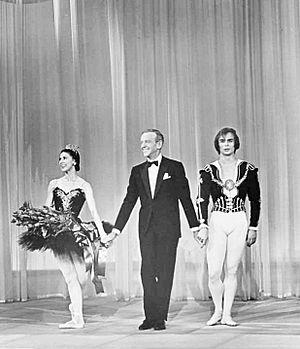
Nureyev first danced with the famous ballerina Dame Margot Fonteyn on February 21, 1962. They performed parts of Giselle and Swan Lake. Their performances were so popular that Fonteyn and Nureyev formed a long-lasting dance partnership. They premiered Romeo and Juliet in 1965. Fans loved them so much they would tear up their programs to make confetti. They would throw it at the dancers. Nureyev and Fonteyn would often take more than 20 bows after a show.
International Performances
Nureyev danced a lot in North America. He had a strong connection with the National Ballet of Canada. He was a guest artist there many times. In 1972, he created a new production of Sleeping Beauty for the company. This show toured widely in the U.S. and Canada. One performance was even shown on TV.
Nureyev often danced with Canadian ballerinas Veronica Tennant and Karen Kain. In 1975, he worked with American Ballet Theatre. He brought back ballets like Le Corsaire, Sleeping Beauty, Swan Lake, and Ramonda.
Leading the Paris Opera Ballet
In January 1982, Nureyev became an Austrian citizen. This ended more than twenty years of not having a country. In 1983, he became the director of the Paris Opera Ballet. He continued to dance and help younger dancers. He stayed there as a dancer and main choreographer until 1989. He helped many dancers like Sylvie Guillem and Manuel Legris.
His time as director of the Paris Opera Ballet was very successful. He helped the company through a difficult period. His version of The Sleeping Beauty is still performed today.
Even when he was ill, he worked very hard. He created new versions of old ballets. He also asked others to create new and exciting dance works. His own Romeo and Juliet was very popular. Towards the end of his life, he worked on a final production of La Bayadère. This version was very similar to the one he danced as a young man.
Final Years and Legacy
Health Challenges
Nureyev was diagnosed with a chronic illness in 1984. For several years, he did not want to admit he was sick. But by the late 1980s, his dancing skills began to decline. This disappointed his fans who remembered his amazing talent. Nureyev's health got much worse in the summer of 1991. He entered the final stage of his illness in the spring of 1992.
In March 1992, he visited Kazan. He appeared as a conductor at the Musa Cälil Tatar Academic Opera and Ballet Theater. This theater now holds the Rudolf Nureyev Festival. He returned to Paris with a high fever. He was admitted to a hospital and had surgery for a heart problem. What kept him fighting was the hope of conducting Prokofiev's Romeo and Juliet. He conducted it at a benefit show in New York in May 1992. He was very happy with the audience's reaction.
In July 1992, Nureyev showed signs of his heart problem again. But he decided not to have more treatment. His last public appearance was on October 8, 1992. It was for the premiere of his new production of La Bayadère at the Palais Garnier. He had found a copy of the original music score in Russia in 1989. The ballet was a great success for him. Even though he was very sick, his talent was clear. The French Culture Minister gave him France's highest cultural award on stage that evening.
Death
Nureyev went back to the hospital on November 20, 1992. He stayed there until he died at age 54 on January 6, 1993. His funeral was held at the Paris Garnier Opera House. Many people spoke about his amazing talent as a dancer. Oleg Vinogradov of the Mariinsky Ballet said, "What Nureyev did in the west, he could never have done here."
Nureyev's grave is at the Russian cemetery near Paris. His tomb looks like it is covered in a mosaic of an Oriental carpet. Nureyev loved collecting beautiful carpets and old fabrics. As his coffin was lowered, music from Giselle played. His ballet shoes and white lilies were placed in the grave.
Tributes and Recognition
After many years, Nureyev's place in the Mariinsky Ballet's history was recognized again. His name was put back into the Mariinsky's history. Some of his personal items are now shown at the theater museum in St. Petersburg. A rehearsal room at the Vaganova Academy was named after him. The Centre National du Costume de Scène has a permanent collection of his costumes. These show his lively personality and love for beautiful things. In 2015, he was honored in the Legacy Walk.
Since his death, the Paris Opera has honored Nureyev with a special dance evening every 10 years. These shows are usually in March, near his birthday. Dancers like Mikhail Baryshnikov speak about Nureyev with great emotion.
On November 7, 2018, a monument honoring Nureyev was revealed in Kazan. It is near the Musa Cälil Tatar Academic Opera and Ballet Theater. The monument was designed by Zurab Tsereteli. Many important people attended the ceremony. The President of Tatarstan said, "Rudolf Nureyev is an international value. Such people are born once in a hundred years."
Nureyev's Dance Style
Influence on Ballet
Nureyev was very strict about classical ballet technique. His amazing skill made him a role model for many dancers. Male dancing improved a lot in the West after the 1960s. This was largely because of Nureyev's inspiration.
Nureyev changed how people saw male dancers. In his own ballets, male roles had much more dancing. He also helped combine classical ballet and modern dance. He performed both styles. Today, dancers learn both, but Nureyev was one of the first to be excellent at both. He worked with modern dance legend Martha Graham. She even created a special dance for him.
Nureyev's charm and dedication were so strong. He did not just share his knowledge. He showed dancers how to live for their art. Several dancers who were main performers under his direction later became ballet directors themselves. They were inspired to continue his work.
Mikhail Baryshnikov, another great dancer who moved to the West, respected Nureyev greatly. Baryshnikov said Nureyev was an amazing person. He had great instincts, intelligence, constant curiosity, and incredible discipline. Dancing was his life's goal and love.
His Quest for Perfection
Nureyev started ballet training later than most. He had to work very hard to perfect his technique. John Tooley wrote that Nureyev grew up very poor. He had to catch up on several years of ballet education. This pushed him to learn as much as possible. He worked on being perfect throughout his whole career. Dancers who worked with Nureyev had to try their best and share his total dedication to dance.
Nureyev explained it this way: "I approach dancing from a different angle than those who begin dancing at 8 or 9. Those who have studied from the beginning never question anything." He joined the Vaganova Ballet Academy at 17. He only stayed for three years. Most dancers become main performers after nine years of training. Nureyev did not become famous through ballet competitions. Instead, his performances and popular image made him a star.
Both Nureyev and Mikhail Baryshnikov became masters of dance perfection. For Nureyev, dance and life were the same. Pierre Bergé said Nureyev was "extraordinary." Manuel Legris said, "Rudolf Nureyev was a high-speed train." Working with him meant pushing yourself to be better.
Personal Connections
Nureyev did not like rules or strict order. He could sometimes have a strong temper. He would get upset in public when things did not go well. This usually happened when other people's mistakes affected his work.
He was friends with many famous people like Jackie Kennedy Onassis and Mick Jagger. He also visited the New York discotheque Studio 54 sometimes. But he later grew tired of celebrities. He kept his old friendships, both in and out of the ballet world, for many years. He was known as a loyal and kind friend.
Many ballerinas who danced with Nureyev said he was a thoughtful partner. These included Antoinette Sibley and Cynthia Gregory. He was very generous to many ballerinas. They said he helped them during hard times. For example, Canadian ballerina Lynn Seymour was upset when she could not premiere a ballet. She said Nureyev often found projects for her, even when she had health challenges.
Nureyev met Erik Bruhn, a famous Danish dancer, after he moved to the West in 1961. Nureyev admired Bruhn greatly. They became close friends and remained connected for 25 years, until Bruhn's death in 1986.
In 1978, Nureyev met Robert Tracy, an American dancer. Tracy later became Nureyev's secretary and lived with him for over 14 years.
Awards and Honors
| Chevalier of the Legion of Honour (France) |
Commandeur of the Ordre des Arts et des Lettres (France) |
Film, Television, and Musical Roles
In 1962, Nureyev appeared in a film version of Les Sylphides. He decided not to pursue an acting career. Instead, he explored modern dance with the Dutch National Ballet in 1968. Nureyev also made his TV debut in America in 1962. He danced with Maria Tallchief on the Bell Telephone Hour.
In 1972, Robert Helpmann invited him to tour Australia. They performed Nureyev's production of Don Quixote. In 1973, a film version of Don Quixote was directed by Nureyev and Helpmann. Nureyev played Basilio in the film.
In 1978, he was a guest star on The Muppet Show. He danced in a parody called "Swine Lake." He also sang "Baby, It's Cold Outside" with Miss Piggy. His appearance helped make the show very popular.
In 1989, he toured the United States and Canada for 24 weeks. He performed in a new version of the Broadway musical The King and I.
Documentary Films
- Rudolf Noureev Exercising at the Barre (1970)
- Nureyev (1981), by Thames Television. This film includes an interview and shows him in the studio.
- Nureyev (1991). This film tells the story of Nureyev's career.
- Rudolf Nureyev – As He Is (1991). This film includes a long interview with Nureyev during his visit to Leningrad in 1990.
- Nureyev: From Russia With Love (2007), by John Bridcut
- Rudolf Nureyev: Rebellious Demon (2012). This film explores Nureyev's life.
- Rudolf Nureev. The Island of his Dream (2016)
- Nureyev: Lifting the Curtain (2018). This film uses old interviews and dance clips to show Nureyev's life.
Repertoire
Here is a list of some of the ballets Nureyev performed or helped create:
- Laurencia – Frondoso
- Swan Lake – Prince Siegfried, Rothbart
- The Nutcracker – Drosselmeyer, Prince
- Sleeping Beauty – Blue Bird, Prince Florimund (Desiree)
- Marguerite and Armand – Armand
- La Bayadere – Solor
- Raymonda – Four Knights, Jean de Brienne
- Giselle – Count Albert
- Don Quixote – Basilio
- Le Corsaire – a slave
- Romeo and Juliet – Romeo, Mercutio
- La Sylphide – James
- Petrushka – Petrushka
- Le Spectre de la rose – The Spirit of the Rose
- Scheherazade – Golden Slave
- Afternoon Rest of the Faun – Faun
- Apollo – Apollo
- The Young Man and Death – Youth
- Prodigal Son
- Phaedra's Dream, choreographed by Martha Graham as the role of Hippolyte.
- Paradise Lost, choreographed by Roland Petit
- Les Sylphides – Youth
- Hamlet by Robert Helpmann – Hamlet
- Cinderella, choreographed and produced Nureyev.
- Gayane, choreographed by Nina Anisimova (solo performance).
- Pierrot Lunaire choreographed by Glen Tetley as the role of Pierrot.
- Lucifer, choreographed by Martha Graham – Lucifer
- Idiot by Valery Panov – Prince Myshkin
- Coppélia
- Songs of a Wayfarer, choreographed by Maurice Béjart
- The Rite of Spring
- The Moor's Pavane – Othello
- Orpheus, choreographed by George Balanchine as the role of Orpheus.
- Songs Without Words, choreographed by Hans van Manen
- The Tempest, choreographed by Nureyev as the role of Prospero.
- Night Journey, choreographed by Martha Graham as the role of Oedipus.
- The Scarlet Letter, choreographed by Martha Graham as the role of Rev. Dimsdale.
- Notre Dame of Paris, choreographed by Roland Petit as the role of Quasimodo.
- La Esmeralda, choreographed by Vakhtang Chabukiani.
- "Ecuatorial", choreographed by Martha Graham, lead with Yuriko Kimura
See also
 In Spanish: Rudolf Nuréyev para niños
In Spanish: Rudolf Nuréyev para niños
- List of dancers
- List of Eastern Bloc defectors
- List of Russian ballet dancers



